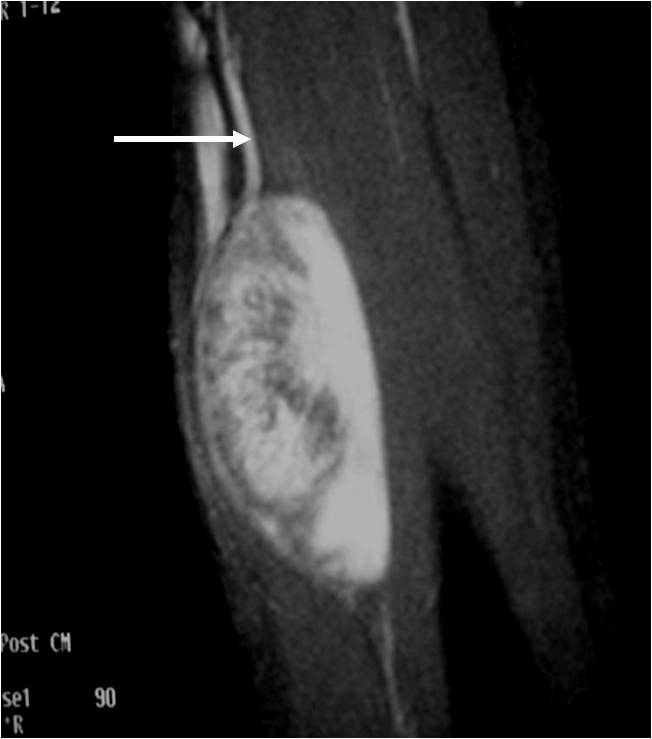What is a Malignant Peripheral Nerve Sheath Tumor?
Malignant Peripheral Nerve Sheath Tumor is a malignant (cancerous) tumor that occurs on the outer, protective covering of nerves. It presents as a mass that could cause some pain or numbness to the surrounding area. It can be associated with neurofibromatosis type 1 (NF-1), which is an inherited condition that those are born with. There is a possibility that the tumor can come back in the same location, known as a recurrence, or that it can spread to other parts of the body, which is why treatment is essential.
Causes
- • Serious complications of NF-1 is the development of malignant peripheral nerve sheath tumor.
Signs and Symptoms
- • Signs and symptoms include pain, a slow growing tumor, and occasionally neurological symptoms.
Who is usually affected?
- • Equally affects males and females.
- • The majority of cases occur between the ages of 20-50, however it can occur at any age.
- • More common in those with neurofibromatosis 1
Common Sites Involved
- • Upper extremities
- • Lower extremities
- • Major nerve trunks
- • Can metastasize to lungs, liver, lymph nodes and other bones.
Biological Behavior
- • Similar and easily confused with a benign schwannoma, however they are usually greater than 5 cm.
- • Associated with serious complications of NF-1.
- • Has the potential to metastasize and can locally recur.
Diagnosis
- • The work-up for malignant peripheral nerve sheath tumor often consists of a physical examination, X-ray, MRI, CT, and bone scans. Also, a bone scan, CT PET scan, and CT chest/abdomen/pelvis may be ordered to check if the tumor has spread, or metastasized, to the chest/abdomen/ pelvis or other parts of the body. The diagnosis is often confirmed with a biopsy, which samples the tumor for further analysis.
Risk to your limbs
Malignant Peripheral Nerve Sheath Tumor is a malignant tumor that occurs on the outer, protective covering of nerves. Soft-tissue sarcomas, such as this one, grow in the soft-tissues of the extremities and compromise or destroy the affected soft-tissue and muscles. These tumors can compress or stretch important vessels and nerves, and occasionally wrap around these structures making it difficult to remove the mass without an amputation. They also have the potential to invade adjacent bones. Without treatment, it can metastasize or spread throughout the body, with the lungs, liver, and bones being the most common sites. Proper and effective treatment is also necessary, as there is a high local recurrence rate in this type of cancer.
Radiographic imaging is used to help form a diagnosis. These include X-Ray, MRI, CT and Bone Scans.
An example of an MRI is shown.

Treatment of Malignant Peripheral Nerve Sheath Tumor
The treatment of malignant peripheral nerve sheath tumor is surgical excision through a limb-sparing surgery. The limb-sparing surgery is usually a wide or radical resection, in which the tumor is removed in its entirety. If the tumor is compressing, stretching, or wrapping around important vessels and nerves, an amputation may be performed instead. Since malignant peripheral nerve sheath tumor can metastasize and recur, chemotherapy is also used as treatment.
Surgery
Surgical treatment includes wide or radical resections to remove the complete tumor and additional margins. The removal of additional, surrounding margins ensures that the tumor is completely removed and decreases the chances of the tumor coming back.
Chemotherapy
Chemotherapy is a systemic treatment option for some cancers, meaning the chemotherapy drugs travel throughout the body and can kill the cancerous cells that have metastasized, or spread throughout. Chemotherapy is used to treat cancer, control/prevent cancer from spreading, and ease the symptoms related to the cancer. There are various drugs used in chemotherapy, so the combinations of drugs administered and the number of cycles may differ between each person and tumor. Lastly, chemotherapy may be used in conjunction with other treatments, specifically local treatments such as surgery.
Radiation
Radiation is a treatment option for some cancers. Radiation therapy is a localized treatment that utilizes high-energy particles or waves to kill cancerous cells. Because radiation therapy is a localized treatment, it only affects the area in which it is set to target and therefore eliminates the risks of damaging healthy cells throughout the body. Not only is it used to treat cancer, but it can also decrease the chances of the cancer from recurring. Lastly, radiation may be used in conjunction with other treatments, such as surgery or chemotherapy, to treat cancers.






